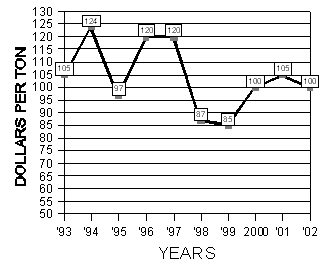Alfalfa Report
Yuma County, Arizona
December 2, 2002
Yuma County Office
2200 W. 28th Street, Ste. 102
Yuma, AZ 85364
(928) 726-3904
(928) 726-8472 FAX
Production Update:
Winter Irrigation: Alfalfa water use from November through February
averages about 3.5 inches per month in the low elevation desert areas.
Winter rainfall cannot usually sustain maximum production in these areas
and some supplemental irrigation is required. If we assume an irrigation
efficiency of 0.7, then a single 5-inch irrigation every month can meet
alfalfa water requirements during the winter on average. The actual irrigation
requirement depends on soil type, weather conditions, rainfall, growth
of the crop, and other factors. Growers sometimes use the winter as a
time to replenish subsoil moisture and apply more water than is actually
required by the crop during this time of the year.
Insect Management: Blue alfalfa aphid (picture)
is a serious pest during the winter and spring months in the low desert.
Blue alfalfa aphid is distinguished from pea aphid (
picture)
by uniformly dark antennae. Pea aphids (
picture)
have lighter antennae with dark bands at each joint. The blue alfalfa
aphid first appears in December or January when it may be more abundant
than pea aphid. Both species are common throughout the spring, but pea
aphid is more heat tolerant and may persist into early summer. In susceptible
alfalfa varieties, blue alfalfa aphid may stunt growth and infested plants
have smaller leaves, shorter internodes, leaf curling, yellowing, and
leaf drop. Several species of predacious bugs and parasitic wasps attack
these aphids. Sample alfalfa fields weekly when aphids appear, then every
2 to 3 days as numbers approach the treatment threshold of 40 to 50 blue
alfalfa aphids per stem.
Weed Control: Some summer annual weeds survive every winter. The most common of these are the grasses, especially sprangletop and sandbur. Preemergent herbicides will not control these survivors when applied in the spring.
| Market Summary |
High
|
Low
|
Average
|
Off grade
|
| Past 2 Weeks ( Nov. 19 - Dec. 2, 2002) |
115
|
90
|
100
|
70-90
|
| Last Year (Nov. 19 - Dec. 2, 2001) |
110
|
90
|
105
|
70-90
|
10 Year Summary (Nov. 19 - Dec. 2, 1993-2002):

Issued in furtherance of Cooperative Extension work, acts of May 8 and June 30, 1914, in cooperation with the U.S. Department of Agriculture, James A. Christenson, Director Cooperative Extension, College of Agriculture and Life Sciences, The University of Arizona.
The University of Arizona is an equal opportunity, affirmative action institution. The University does not discriminate on the basis of race, color, religion, sex, national origin, age, disability, veteran status, or sexual orientation in its programs and activities.
Any products, services, or organizations that are
mentioned, shown, or indirectly implied in this web document do not imply
endorsement by The University of Arizona.
Information provided by:
Barry Tickes, btickes@ag.arizona.edu Extension Agent, Yuma County
Michael Ottman, mottman@ag.arizona.edu Agronomy Specialist
College of Agriculture, The University of Arizona.
Eric Natwick, etnatwick@ucdavis.edu UCCE Imperial County - Farm Advisor
University of California, Davis, CA.
Forages: Crop Mgmt | Soil Mgmt | Irrigation | Alfalfa Reports | Insects | Diseases | Weeds | Pesticides
Home | Other Crops | Forages
For more Arizona Production Ag Information:
Home | Cotton | Veggies| Forages | Grains | Citrus | Crop x Crop | Insects | Diseases| Weeds | Pesticides | News | Weather | Research | Photos | Contacts | General Info. | Site Map
Copyright © 2001 University of Arizona,
College of Agriculture and Life Sciences
Webmaster: Al Fournier (fournier@ag.arizona.edu)